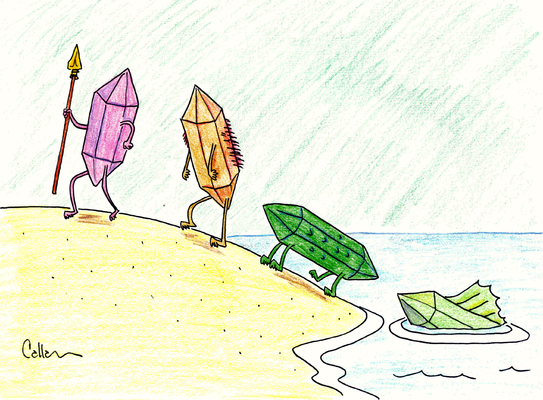
by Brian Fisher Johnson Thursday, January 5, 2012

Callan Bentley
Taxonomy, the science of classification, connects creatures through genealogical relationships. But taxonomist Carl Linné (Linnaeus) didn't stop with living organisms; he applied his system to all natural objects — even minerals. And according to a new study, he may have been on to something: Iron may not pass genes to its rusted cousin iron oxide, but like living organisms, minerals have evolved considerably over the course of Earth’s history.
About 4.6 billion years ago, during the earliest years of our solar system, Earth was nothing more than a molten pile-up of crashed meteorites enveloped by a cooler crust. Based on studies of modern meteorites, scientists think our planet hosted about 250 different minerals at the time, says Robert Hazen, a research scientist at the Carnegie Institution of Washington and lead author of the study.
Over the next 2 billion years, however, Earth’s churning interior minted new minerals. In what would become the process of plate tectonics, the coolest, densest portions of Earth’s crust sank back into the hotter interior and allowing molten material to flow forth from the gaps left behind. This cooling and heating of rocks, along with the infusion of water that would come to fill our ocean basins, concentrated Earth’s elements, creating geologic mixing bowls that cooked out even more varieties of minerals from the original mineralogical ingredients. That brought the total number of mineral types to about 1,500, Hazen and colleagues wrote in November in American Mineralogist.
But Earth’s mineral story didn’t stop there. Its rocks had something special in store: life.
Scientists are still working through the scenarios that could have formed life. Many scientists are confident about one thing, however: Minerals, whether through volcanic eruptions, hydrothermal vents or asteroid impacts, helped to generate the organic building blocks from which all life evolved. But the moral of this story, Hazen says, is that life led to the “evolution” of nearly 3,000 new minerals.
The realization that life and minerals co-evolved has forced Hazen to think differently about early Earth, he says. Think back to the example of iron turning into iron oxide: Iron rusts because our atmosphere is flush with oxygen that binds to exposed iron. Most of that oxygen came from oxygen-releasing plants and bacteria, which began to produce large amounts of oxygen about 2.2 billion years ago, during a period called the Great Oxidation Event. “If you took that same piece of iron 4 billion years ago and put it at Earth’s surface, it would … hardly alter at all for thousands, maybe millions of years,” Hazen says. In today's oxygen-rich atmosphere, it would oxidize.
Rock evolution might impact the type of mineral evidence NASA seeks in its search for life beyond our planet, Hazen says. In addition to the clays studied in past missions, for example, scientists might also look for sulfides or pegmatites, minerals that might indicate the melting and fluid circulation that led to life on Earth.
The realization that life and minerals co-evolved may also help museums think differently about how they display their mineral collections, a resource that is less appreciated in the age of computers, says David Saja, head of mineralogy at the Cleveland Museum of Natural History in Ohio. (In 2006, the Academy of Natural Sciences in Philadelphia, Pa., auctioned off part of its mineral collection in an effort to keep financially afloat.) But mineral evolution may restore interest in these mineral collections, Saja says. The Cleveland Museum has "exhibits that start with the Big Bang, show the formation of stars and planets and eventually jump into single-celled organisms and how they evolved," he says. "I think mineral evolution will be the missing link that ties everything together."
© 2008-2021. All rights reserved. Any copying, redistribution or retransmission of any of the contents of this service without the expressed written permission of the American Geosciences Institute is expressly prohibited. Click here for all copyright requests.